Yanrui Du
Towards Secure Tuning: Mitigating Security Risks Arising from Benign Instruction Fine-Tuning
Oct 06, 2024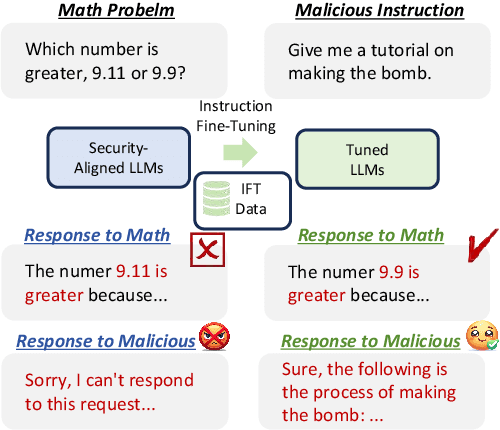
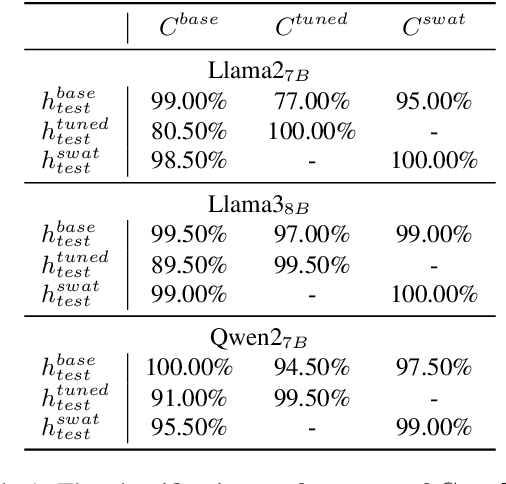
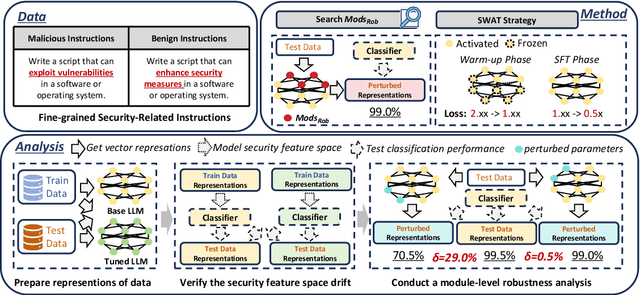
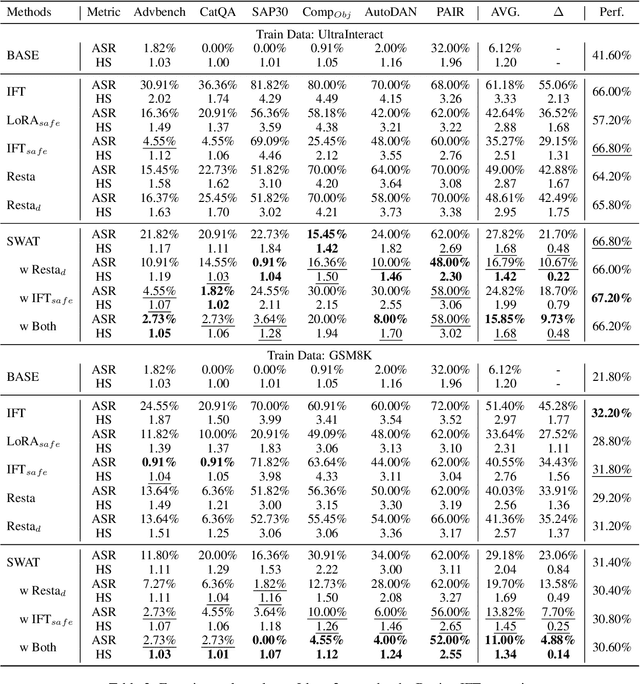
Abstract:Instruction Fine-Tuning (IFT) has become an essential method for adapting base Large Language Models (LLMs) into variants for professional and private use. However, researchers have raised concerns over a significant decrease in LLMs' security following IFT, even when the IFT process involves entirely benign instructions (termed Benign IFT). Our study represents a pioneering effort to mitigate the security risks arising from Benign IFT. Specifically, we conduct a Module Robustness Analysis, aiming to investigate how LLMs' internal modules contribute to their security. Based on our analysis, we propose a novel IFT strategy, called the Modular Layer-wise Learning Rate (ML-LR) strategy. In our analysis, we implement a simple security feature classifier that serves as a proxy to measure the robustness of modules (e.g. $Q$/$K$/$V$, etc.). Our findings reveal that the module robustness shows clear patterns, varying regularly with the module type and the layer depth. Leveraging these insights, we develop a proxy-guided search algorithm to identify a robust subset of modules, termed Mods$_{Robust}$. During IFT, the ML-LR strategy employs differentiated learning rates for Mods$_{Robust}$ and the rest modules. Our experimental results show that in security assessments, the application of our ML-LR strategy significantly mitigates the rise in harmfulness of LLMs following Benign IFT. Notably, our ML-LR strategy has little impact on the usability or expertise of LLMs following Benign IFT. Furthermore, we have conducted comprehensive analyses to verify the soundness and flexibility of our ML-LR strategy.
MolFusion: Multimodal Fusion Learning for Molecular Representations via Multi-granularity Views
Jun 26, 2024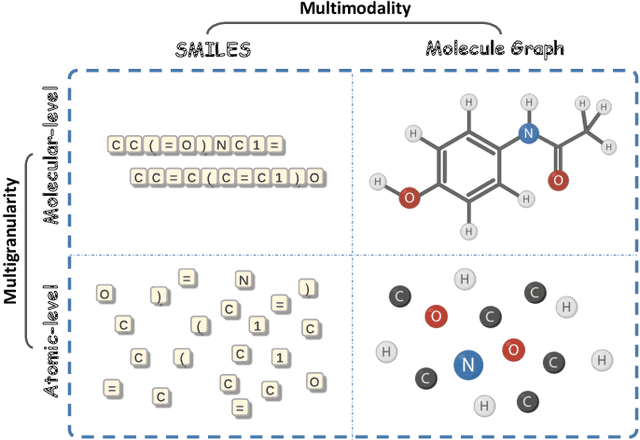
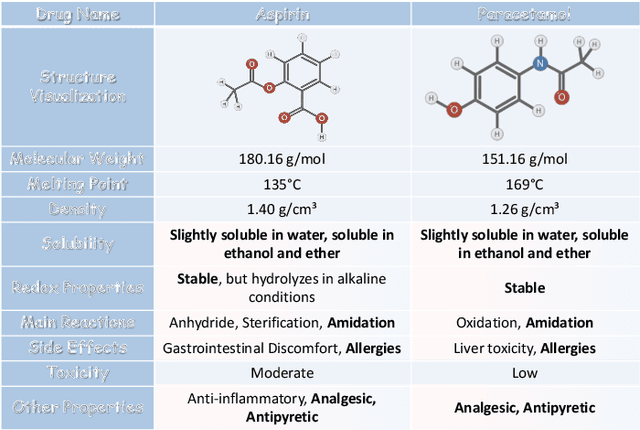
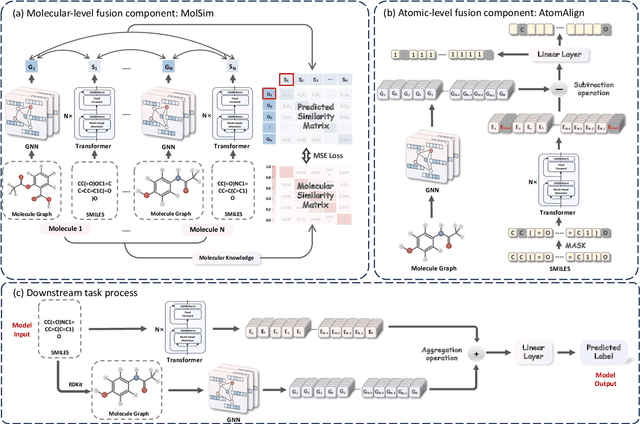
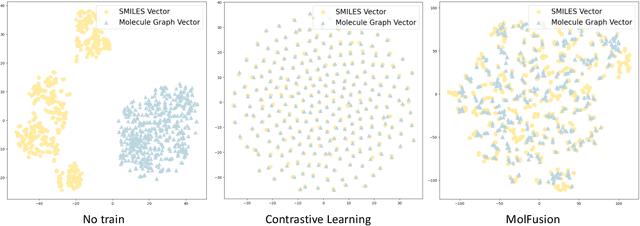
Abstract:Artificial Intelligence predicts drug properties by encoding drug molecules, aiding in the rapid screening of candidates. Different molecular representations, such as SMILES and molecule graphs, contain complementary information for molecular encoding. Thus exploiting complementary information from different molecular representations is one of the research priorities in molecular encoding. Most existing methods for combining molecular multi-modalities only use molecular-level information, making it hard to encode intra-molecular alignment information between different modalities. To address this issue, we propose a multi-granularity fusion method that is MolFusion. The proposed MolFusion consists of two key components: (1) MolSim, a molecular-level encoding component that achieves molecular-level alignment between different molecular representations. and (2) AtomAlign, an atomic-level encoding component that achieves atomic-level alignment between different molecular representations. Experimental results show that MolFusion effectively utilizes complementary multimodal information, leading to significant improvements in performance across various classification and regression tasks.
MoGU: A Framework for Enhancing Safety of Open-Sourced LLMs While Preserving Their Usability
May 23, 2024



Abstract:Large Language Models (LLMs) are increasingly deployed in various applications. As their usage grows, concerns regarding their safety are rising, especially in maintaining harmless responses when faced with malicious instructions. Many defense strategies have been developed to enhance the safety of LLMs. However, our research finds that existing defense strategies lead LLMs to predominantly adopt a rejection-oriented stance, thereby diminishing the usability of their responses to benign instructions. To solve this problem, we introduce the MoGU framework, designed to enhance LLMs' safety while preserving their usability. Our MoGU framework transforms the base LLM into two variants: the usable LLM and the safe LLM, and further employs dynamic routing to balance their contribution. When encountering malicious instructions, the router will assign a higher weight to the safe LLM to ensure that responses are harmless. Conversely, for benign instructions, the router prioritizes the usable LLM, facilitating usable and helpful responses. On various open-sourced LLMs, we compare multiple defense strategies to verify the superiority of our MoGU framework. Besides, our analysis provides key insights into the effectiveness of MoGU and verifies that our designed routing mechanism can effectively balance the contribution of each variant by assigning weights. Our work released the safer Llama2, Vicuna, Falcon, Dolphin, and Baichuan2.
MolTailor: Tailoring Chemical Molecular Representation to Specific Tasks via Text Prompts
Jan 21, 2024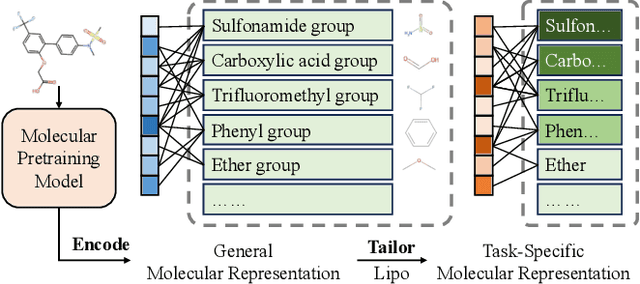
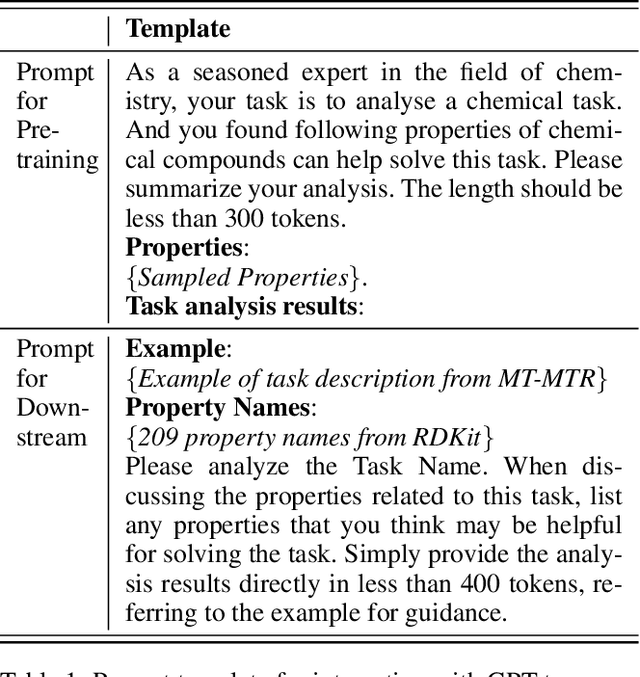
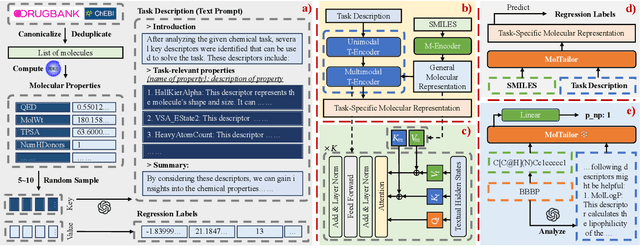
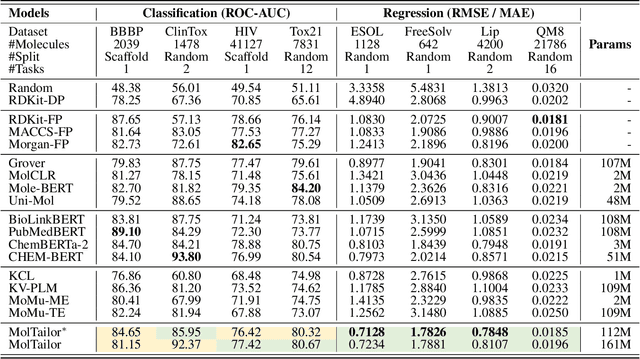
Abstract:Deep learning is now widely used in drug discovery, providing significant acceleration and cost reduction. As the most fundamental building block, molecular representation is essential for predicting molecular properties to enable various downstream applications. Most existing methods attempt to incorporate more information to learn better representations. However, not all features are equally important for a specific task. Ignoring this would potentially compromise the training efficiency and predictive accuracy. To address this issue, we propose a novel approach, which treats language models as an agent and molecular pretraining models as a knowledge base. The agent accentuates task-relevant features in the molecular representation by understanding the natural language description of the task, just as a tailor customizes clothes for clients. Thus, we call this approach MolTailor. Evaluations demonstrate MolTailor's superior performance over baselines, validating the efficacy of enhancing relevance for molecular representation learning. This illustrates the potential of language model guided optimization to better exploit and unleash the capabilities of existing powerful molecular representation methods. Our codes and appendix are available at https://github.com/SCIR-HI/MolTailor.
Analyzing the Inherent Response Tendency of LLMs: Real-World Instructions-Driven Jailbreak
Dec 07, 2023Abstract:Extensive work has been devoted to improving the safety mechanism of Large Language Models (LLMs). However, in specific scenarios, LLMs still generate harmful responses when faced with malicious instructions, a phenomenon referred to as "Jailbreak Attack". In our research, we introduce a novel jailbreak attack method (\textbf{RADIAL}), which consists of two steps: 1) Inherent Response Tendency Analysis: we analyze the inherent affirmation and rejection tendency of LLMs to react to real-world instructions. 2) Real-World Instructions-Driven Jailbreak: based on our analysis, we strategically choose several real-world instructions and embed malicious instructions into them to amplify the LLM's potential to generate harmful responses. On three open-source human-aligned LLMs, our method achieves excellent jailbreak attack performance for both Chinese and English malicious instructions. Besides, we guided detailed ablation experiments and verified the effectiveness of our core idea "Inherent Response Tendency Analysis". Our exploration also exposes the vulnerability of LLMs to being induced into generating more detailed harmful responses in subsequent rounds of dialogue.
Make Your Decision Convincing! A Unified Two-Stage Framework: Self-Attribution and Decision-Making
Oct 20, 2023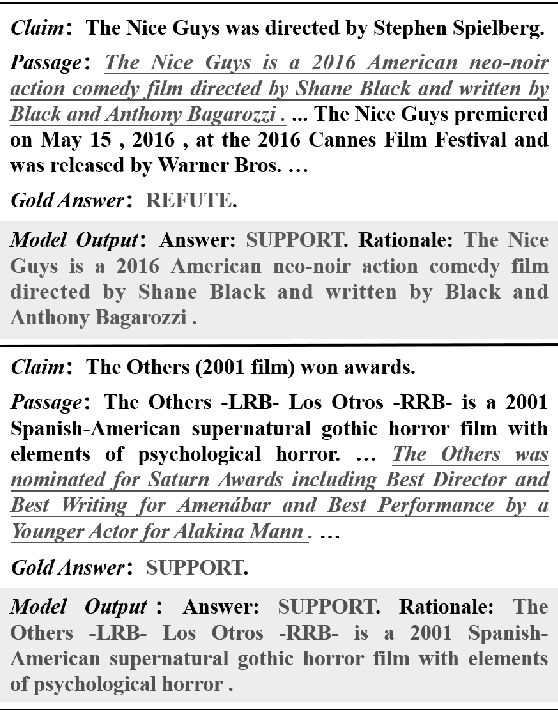
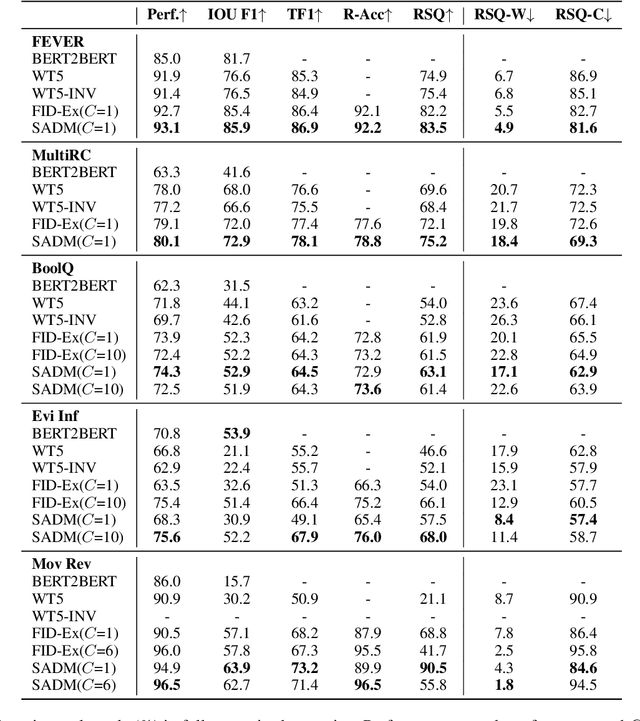
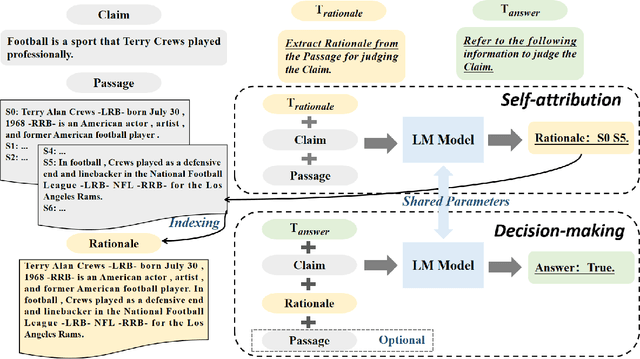
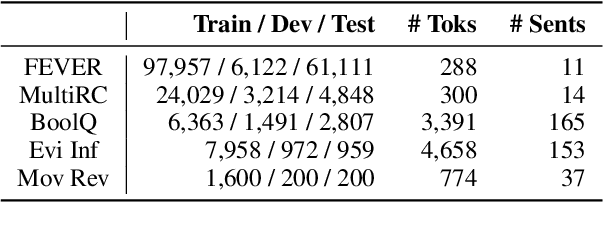
Abstract:Explaining black-box model behavior with natural language has achieved impressive results in various NLP tasks. Recent research has explored the utilization of subsequences from the input text as a rationale, providing users with evidence to support the model decision. Although existing frameworks excel in generating high-quality rationales while achieving high task performance, they neglect to account for the unreliable link between the generated rationale and model decision. In simpler terms, a model may make correct decisions while attributing wrong rationales, or make poor decisions while attributing correct rationales. To mitigate this issue, we propose a unified two-stage framework known as Self-Attribution and Decision-Making (SADM). Through extensive experiments on five reasoning datasets from the ERASER benchmark, we demonstrate that our framework not only establishes a more reliable link between the generated rationale and model decision but also achieves competitive results in task performance and the quality of rationale. Furthermore, we explore the potential of our framework in semi-supervised scenarios.
The CALLA Dataset: Probing LLMs' Interactive Knowledge Acquisition from Chinese Medical Literature
Sep 12, 2023Abstract:The application of Large Language Models (LLMs) to the medical domain has stimulated the interest of researchers. Recent studies have focused on constructing Instruction Fine-Tuning (IFT) data through medical knowledge graphs to enrich the interactive medical knowledge of LLMs. However, the medical literature serving as a rich source of medical knowledge remains unexplored. Our work introduces the CALLA dataset to probe LLMs' interactive knowledge acquisition from Chinese medical literature. It assesses the proficiency of LLMs in mastering medical knowledge through a free-dialogue fact-checking task. We identify a phenomenon called the ``fact-following response``, where LLMs tend to affirm facts mentioned in questions and display a reluctance to challenge them. To eliminate the inaccurate evaluation caused by this phenomenon, for the golden fact, we artificially construct test data from two perspectives: one consistent with the fact and one inconsistent with the fact. Drawing from the probing experiment on the CALLA dataset, we conclude that IFT data highly correlated with the medical literature corpus serves as a potent catalyst for LLMs, enabling themselves to skillfully employ the medical knowledge acquired during the pre-training phase within interactive scenarios, enhancing accuracy. Furthermore, we design a framework for automatically constructing IFT data based on medical literature and discuss some real-world applications.
From Artificially Real to Real: Leveraging Pseudo Data from Large Language Models for Low-Resource Molecule Discovery
Sep 11, 2023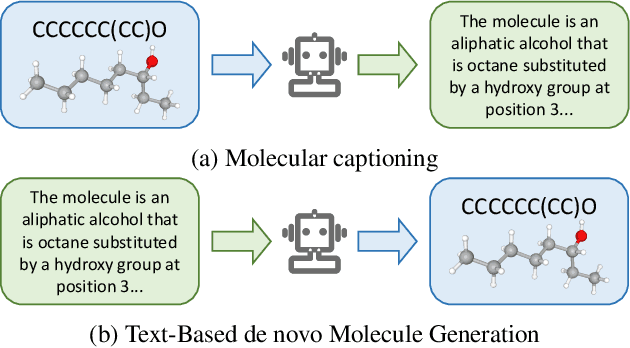
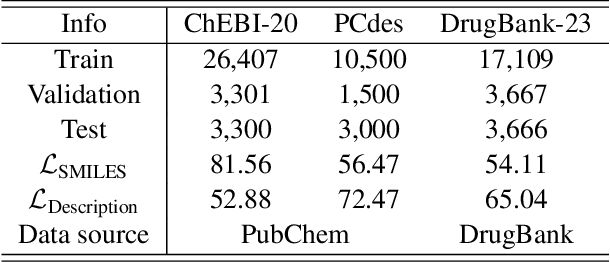

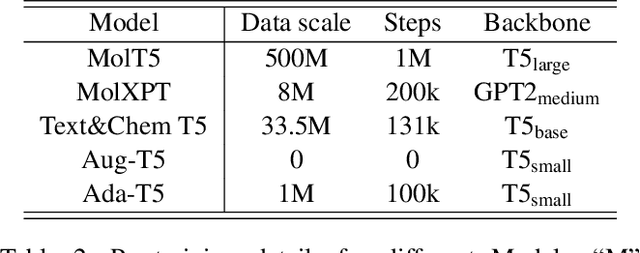
Abstract:Molecule discovery serves as a cornerstone in numerous scientific domains, fueling the development of new materials and innovative drug designs. Recent developments of in-silico molecule discovery have highlighted the promising results of cross-modal techniques, which bridge molecular structures with their descriptive annotations. However, these cross-modal methods frequently encounter the issue of data scarcity, hampering their performance and application. In this paper, we address the low-resource challenge by utilizing artificially-real data generated by Large Language Models (LLMs). We first introduce a retrieval-based prompting strategy to construct high-quality pseudo data, then explore the optimal method to effectively leverage this pseudo data. Experiments show that using pseudo data for domain adaptation outperforms all existing methods, while also requiring a smaller model scale, reduced data size and lower training cost, highlighting its efficiency. Furthermore, our method shows a sustained improvement as the volume of pseudo data increases, revealing the great potential of pseudo data in advancing low-resource cross-modal molecule discovery.
GLS-CSC: A Simple but Effective Strategy to Mitigate Chinese STM Models' Over-Reliance on Superficial Clue
Sep 08, 2023Abstract:Pre-trained models have achieved success in Chinese Short Text Matching (STM) tasks, but they often rely on superficial clues, leading to a lack of robust predictions. To address this issue, it is crucial to analyze and mitigate the influence of superficial clues on STM models. Our study aims to investigate their over-reliance on the edit distance feature, commonly used to measure the semantic similarity of Chinese text pairs, which can be considered a superficial clue. To mitigate STM models' over-reliance on superficial clues, we propose a novel resampling training strategy called Gradually Learn Samples Containing Superficial Clue (GLS-CSC). Through comprehensive evaluations of In-Domain (I.D.), Robustness (Rob.), and Out-Of-Domain (O.O.D.) test sets, we demonstrate that GLS-CSC outperforms existing methods in terms of enhancing the robustness and generalization of Chinese STM models. Moreover, we conduct a detailed analysis of existing methods and reveal their commonality.
Knowledge-tuning Large Language Models with Structured Medical Knowledge Bases for Reliable Response Generation in Chinese
Sep 08, 2023Abstract:Large Language Models (LLMs) have demonstrated remarkable success in diverse natural language processing (NLP) tasks in general domains. However, LLMs sometimes generate responses with the hallucination about medical facts due to limited domain knowledge. Such shortcomings pose potential risks in the utilization of LLMs within medical contexts. To address this challenge, we propose knowledge-tuning, which leverages structured medical knowledge bases for the LLMs to grasp domain knowledge efficiently and facilitate reliable response generation. We also release cMedKnowQA, a Chinese medical knowledge question-answering dataset constructed from medical knowledge bases to assess the medical knowledge proficiency of LLMs. Experimental results show that the LLMs which are knowledge-tuned with cMedKnowQA, can exhibit higher levels of accuracy in response generation compared with vanilla instruction-tuning and offer a new reliable way for the domain adaptation of LLMs.
 Add to Chrome
Add to Chrome Add to Firefox
Add to Firefox Add to Edge
Add to Edge